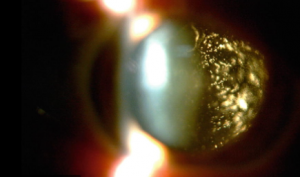If eye floaters are affecting your vision, effective treatments are now available to give you relief.
Eye floaters cause visual disturbances and can become so bothersome that they require treatment from an eye doctor.
Treatment for eye floaters
Eye floaters can be just irritating shadows in your vision or caused by serious retinal diseases.
Fortunately, there are two different treatments that can be performed to reduce the presence of eye floaters, and sometimes even eliminate them entirely:
- Vitrectomy
- Vitreolysis
What is a vitrectomy?
A vitrectomy is the primary treatment for eye floaters.
This procedure involves removing the vitreous in order to totally eliminate the collagen fibers that are causing the eye floaters.
What to expect during a vitrectomy procedure
A vitrectomy is a safe and relatively quick procedure that is generally performed under local anesthesia. During this procedure, a small incision is made and the vitreous is removed. A new fluid made of saline or silicone oil is then inserted into the space of the vitreous.
What to expect following a vitrectomy
Following this procedure, an antibiotic ointment is applied to the eye to prevent infection, and an eye patch is placed over the eye to protect it while it heals.
It may take a couple of weeks to notice total vision improvement, though it is important to speak with your doctor to find out what is to be expected in your individual circumstances.
Are there any complications associated with vitrectomy?
As with any surgical procedure, there are some risks to consider before undergoing a vitrectomy. The most common risks include eye damage, infection, bleeding, high eye pressure, retinal detachment, cataracts, and changes to any pre-existing refractive error.
If you are not a candidate for a vitrectomy, your eye doctor may recommend a laser procedure, called a vitreolysis, to treat your eye floaters.
If you suspect you have eye floaters, contact an eye doctor near you, who can diagnose and treat the condition.
SEE RELATED: Eye Floaters: Should I Worry?
What is a YAG laser vitreolysis procedure?
YAG laser vitreolysis, commonly called vitreolysis, is a non-invasive, highly effective, pain-free laser procedure that has shown to reduce or even eliminate eye floaters.
Vitreolysis uses a laser to diminish the size and thickness of eye floaters.
This reduces the retinal shadows and visual disturbances caused by eye floaters in order to restore clear vision and allow patients to return to their daily activities with improved functioning and quality of life.
What to expect during a vitreolysis procedure
This in-office procedure is performed under local anesthesia, and typically takes around 20-30 minutes to perform. Some patients require up to three laser treatments over the course of four to six weeks in order to gain the full benefits of the procedure.
During this laser procedure, a specialized contact lens will be placed on top of the eye. A laser is then focused onto the surface of the floater, and its energy is used to convert the collagen fibers into a gas. This gas is then reabsorbed into the eye, thereby eliminating the fibrous string.
Are there complications associated with vitreolysis?
Vitreolysis has been around for the past 50 years and has shown to be an effective treatment method. However, unfortunately, vitreolysis is generally not widely performed because it can be difficult to identify the fibers and safely and effectively perform the procedure.
The high levels of laser energy also pose a significant risk of eye damage, cataracts and high intraocular pressure (IOP). As a result, vitreolysis is generally only performed by eye doctors with years of experience in performing this type of procedure.
Who is a candidate for vitreolysis?
Vitreolysis is most effective on patients who are experiencing floaters caused by a posterior vitreous detachment (PVD).
These types of floaters are more fibrous, and therefore able to absorb the laser energy more efficiently. Moreover, these floaters are generally located at a safe distance from the eye’s lens and retina, therefore enabling a safer laser administration.
When to treat eye floaters
If eye floaters are affecting your ability to perform routine activities, such as reading, driving, or watching TV, and are truly impacting your quality of life, speak to your doctor about treating them.
Treating eye floaters may not always be necessary, but when they get in the way of your vision and impact your quality of life, there are now effective treatments that can help to alleviate your discomfort.
LEARN MORE: Guide to Eye Conditions
Schedule an appointment with an eye doctor for a comprehensive eye exam, and to discuss any questions you may have about treating your eye floaters.










